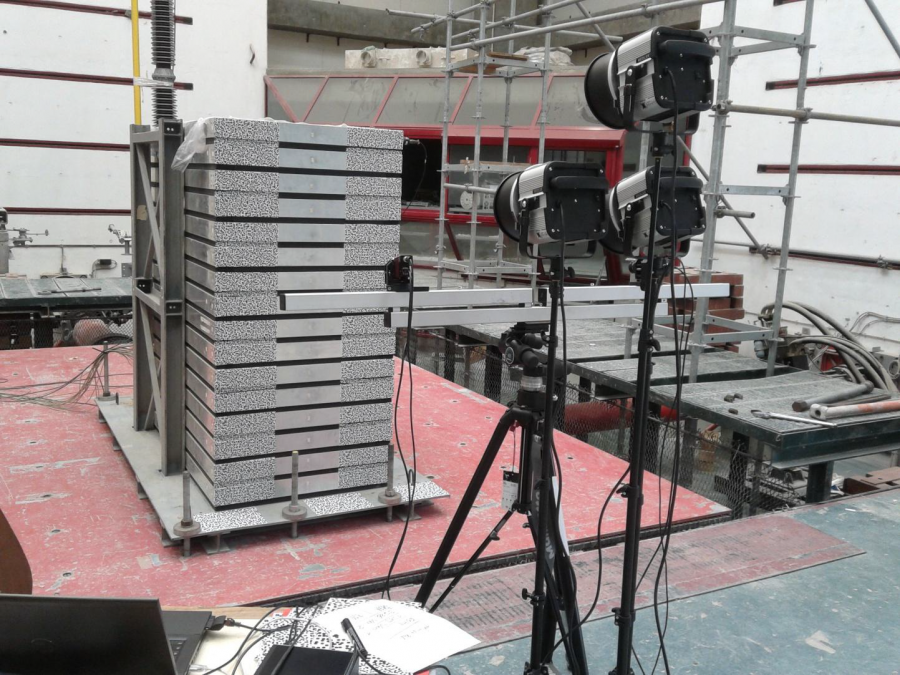
The correlation of an earthquakesimulation
was measured with the Vic-system and high speed cameras.
Several concrete slap was stockpiled on
a shakertable for the experimental setup.
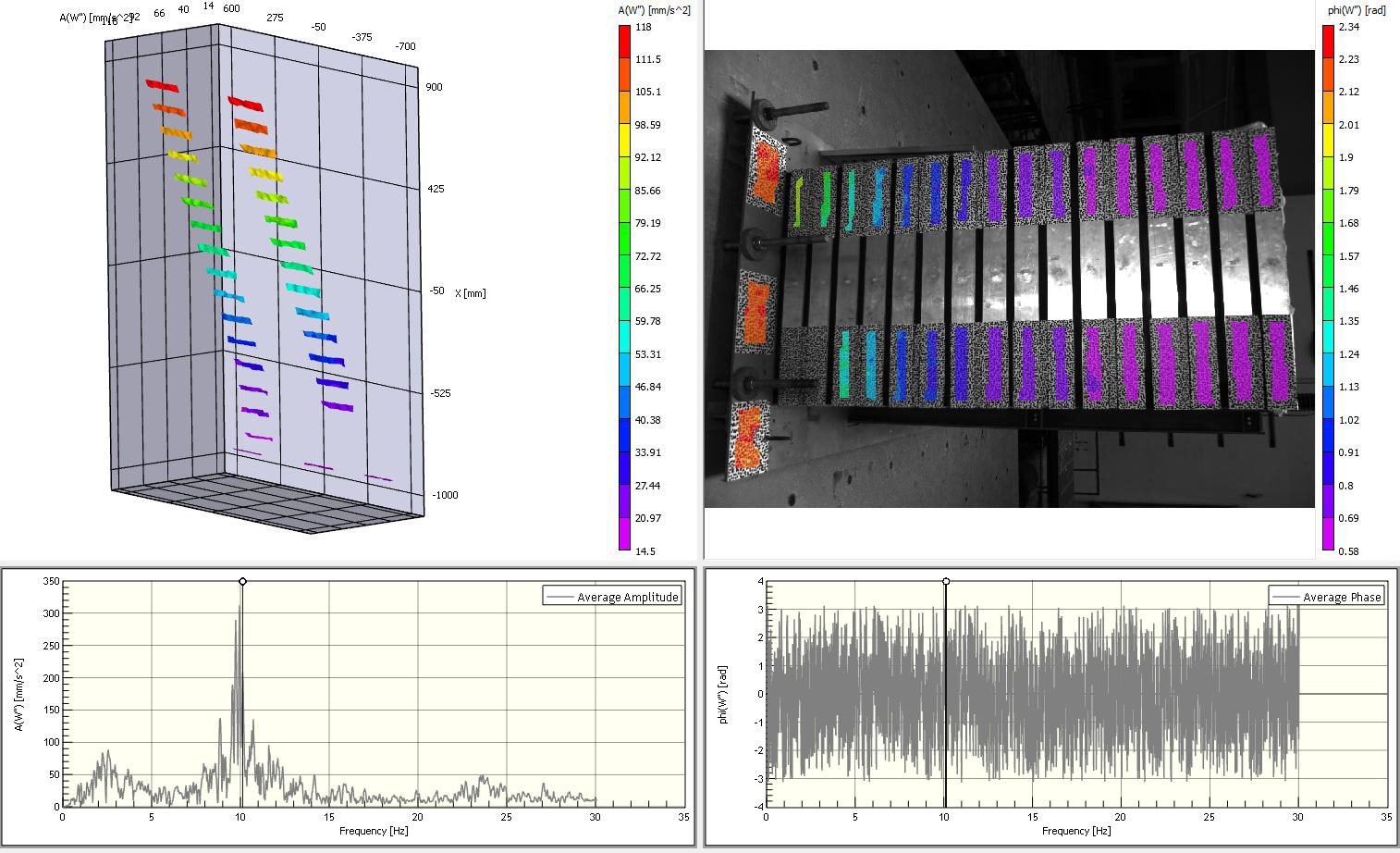

The correlation of an earthquakesimulation
was measured with the Vic-system and high speed cameras.
Several concrete slap was stockpiled on
a shakertable for the experimental setup.

Biomechanic researchers were studying the contractions of a rat Tibialis Anterior muscle. It was desirable to quickly and accurately quantify the overall movements, as well as localized variations.
Because the experiments involved live tissues, conventional gauges were difficult to apply and tended to interfere with the motion under study. It was important to capture data quickly, and for as many points as possible. Marker tracking had been used, but provided only gross averages. It was also time-consuming and tedious for the researchers to process this type of information.
The Vic-3D system was used to rapidly capture contraction data over the entire muscle surface. Due to the system’s speed and simplicity, it was possible to make numerous measurements at precisely timed intervals. There was no interaction with the specimen, and no need to guess which areas would be of greatest interest.
The resulting measurements provided high spatial resolution and made it possible to identify numerous areas where “bunching” of the muscle tissue caused significant variations in muscle contraction. These areas had not been previously identified with conventional methods. Finally, all calculations were done automatically. This saved considerable time and avoided the possibility of human error in the data processing.
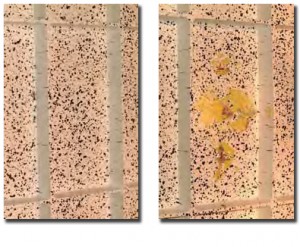 Airbus has built a reputation for innovative aircraft, recognized around the world for their safety and efficiency. All of these attributes are driven by a top-notch testing program, whose innovative practice are evidenced by their use of the Vic-3D measurement system.
Airbus has built a reputation for innovative aircraft, recognized around the world for their safety and efficiency. All of these attributes are driven by a top-notch testing program, whose innovative practice are evidenced by their use of the Vic-3D measurement system.
One of the goals of the Airbus testing program is to characterize the structural damage caused by collisions between the aircraft and small projectiles such as birds and other ground based debris, and to ensure that the structural integrity of the aircraft is maintained.
This type of event can be reproduced by firing a variety of different types of projectile at a piece of aircraft structure at a high velocity. The results obtained can be used to compare with computer models of the structure under impact loads, leading to more highly optimized and safer designs.
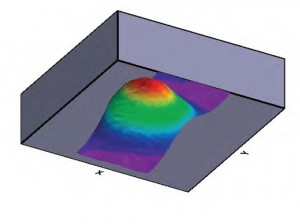 Dr. Richard Burguete, experimental mechanics specialist at Airbus UK since 1997, explains the benefits of this approach as follows: “The VIC-3D system allows us to be sure we have captured all of the relevant data, some of which might have otherwise been unobtainable.”
Dr. Richard Burguete, experimental mechanics specialist at Airbus UK since 1997, explains the benefits of this approach as follows: “The VIC-3D system allows us to be sure we have captured all of the relevant data, some of which might have otherwise been unobtainable.”


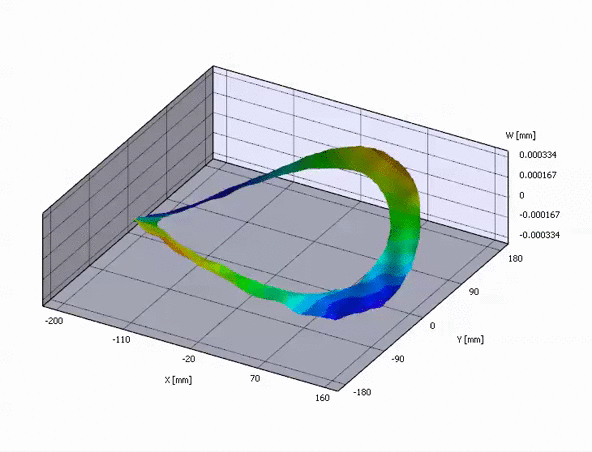
In this example, a 14” diameter brake disc from a heavyduty truck was excited using a small hammer to measure the vibration shapes of the rotor. The three-dimensional operational deflection shapes were easily identified and measured using the Vic-3D™ HS Vibration Analysis System. Amplitudes as small as 40 nanometers were measured at a frequency of approximately 2,000 Hz.
Assembled components typically have complex interactions with one another. Contact points can vary during operational cycles due to part movement. This means that the locations of peak strains can be hard to predict, and they are often not stationary. The movement of parts can also make it impractical to maintain electrical connections with gauges. Even when they are stationary and easy to locate, the highest strains can be concentrated in very small areas or have high gradients. Peak values may be lost to the averaging effect produced by gauges.
Vic-3D provided a means for making strain measurements across the entire profile of the gear tooth. Because it provides full-field measurements, it was not necessary to choose a particular point at which measurements would be made. This allowed the peak strains to be clearly visualized and accurately measured at various stages of the operational cycle. Vic-3D also measured displacement in three dimensions. This feature allowed our customer to recognize and quantify twisting of the gear tooth under load.
 The engineers at Cummins design and test their engines to withstand real-world conditions, ranging from military deployments to heavy-duty industrial sites. Cummins engineers want to know exactly how their parts are deforming under the combination of thermal and mechanical loads. This means they’ve got to perform their tests with the engines running – and hot.
The engineers at Cummins design and test their engines to withstand real-world conditions, ranging from military deployments to heavy-duty industrial sites. Cummins engineers want to know exactly how their parts are deforming under the combination of thermal and mechanical loads. This means they’ve got to perform their tests with the engines running – and hot.
Because of the complex strain fields produced under these conditions, conventional gauges cannot satisfy Cummins’ requirements. FEA simulations are also limited, due to the uncertain boundary conditions. With the Vic-3D system, Cummins engineers are able to obtain detailed three-dimensional strain measurements. These measurements are made under real loading conditions while the engine is running. In addition, the Vic-3D system is easy to set up and can measure both small parts and large assemblies.
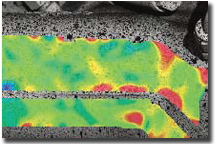
Paul Gloeckner, senior research engineer at Cummins, explains the usefulness of the Vic-3D system as follows: “This tool allows us to make measurements that were previously not possible. It has also allowed us to considerably reduce the time required for these tests.”
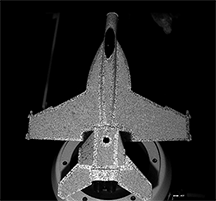

The Vic-3D™ Vibration Analysis System by Correlated Solutions, Inc. is a new addition to the Vic-3D product line of measurement solutions. Vic-3D Vibration enables full-field 3D viewing, measurement, and analysis of transient events. Full-field operational deflection shapes in the frequency domain can easily be seen and compared with levels of accuracy in the nanometer range.
The image above on the left is a mounted model jet plane which has undergone a transient vibration event. To the right, the 3D vibration data obtained from the event is shown as a 2D contour overlay on this image. The data overlay enables the user to see exactly how much deformation is occurring and where it is occurring. This information is available at each frequency where deflection shapes occur.
The data below displays one operational deflection shape obtained with the VIC-3D™ Vibration Analysis System. Three-dimensional displacements, strains, velocities, and accelerations can all be computed in the analysis software. The result is not only visual, but also enables the user to export quantitative data (ASCII, MatLab, CSV, etc.) from the sample’s behavior for FEA analysis and validation. A 3D animation of the model jet’s operational deflection shape at 441 Hz is shown below, with only 12 microns of displacement amplitude.
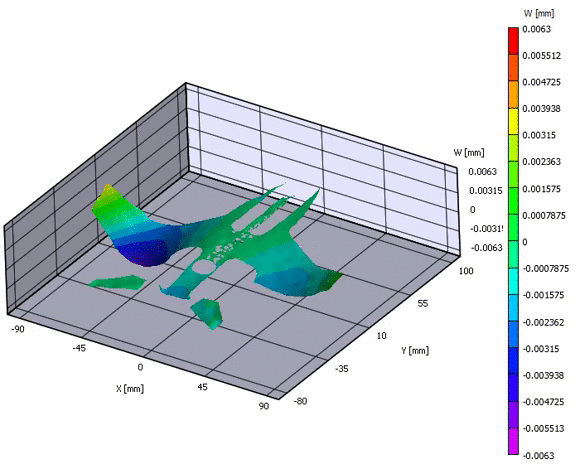
Transient vibration analysis is the process of monitoring, measuring, and analyzing the condition of samples during a transient event. Material properties can also be observed through the analysis of operational deflection shapes and mode shapes created by the event. These full-field 3D shapes can provide useful information which can be used to improve and correct a sample’s balance, displacement, flexure, rigidity, and overall product performance. Measuring operational deflection shapes can help answer the question: “How much is this structure actually moving at a particular frequency?”
Operational deflection shapes created from transient tests show how a sample can have a nonuniform thicknesses, surface irregularities, weak points, cracks and/or other imperfections & flaws. This information can be useful at any point in the process of achieving your overall goal, from writing a project proposal to testing a functional or failing part in the field: The Vic-3D™ Vibration Analysis System
Examples of transient events which can be measured are the following:
| ▪ Door Slams | ▪ Modal Hammer Strikes |
| ▪ Engine Start-ups | ▪ Drop Tests |
| ▪ Explosive Testing | ▪ Ballistic Testing |
While traditional vibration measurement techniques can be useful, they also have many drawbacks. For example, accelerometers can become unglued during testing, can mass-load a sample, and can only provide point to point measurements, often only in a single plane. Pre-testing and testing can also take days or even weeks to perform on large structures. With the Vic-3D™ Vibration Analysis system, there are no adhesives, wires, signal analyzers, power amplifiers, or load cells necessary for detailed vibration results. Obtaining thousands of data points for a tiny, complex structure or a large one is as easy as changing a pair of lenses. Similar to digital image correlation, laser vibrometers can provide a non-contact measurement solution, but similar to accelerometers, they are also only able provide point to point measurements. A 3D measurement can be achieved with multiple scanning vibrometers, but these are usually mounted on large robot arms which can take up valuable laboratory space and cannot be moved easily once installed. Additionally, these systems are unreasonably expensive for many applications. The Vic-3D™ Vibration Analysis system can be taken into the field with any compatible laptop and together with the Vic-3D™ Workstation, the system can become mobile and secure inside your facility. Vic-3D Vibration Analysis is only a fraction of the price of a 3D scanning laser vibrometer system, and since the module can be added onto any existing 3D system, it’s even more affordable.